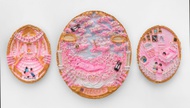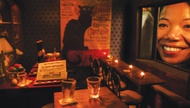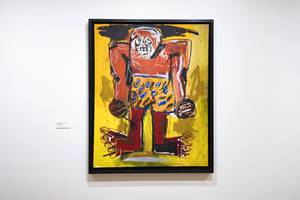
Myranda Bair, All that Glitters Through September 23; Monday-Thursday, 10 a.m.-8 p.m.; Friday-Sunday, 10 a.m.-6 p.m.; free. Sahara West Library Gallery, 702-507-3630.
To pickle a trout, you need heaps of white wine vinegar, or in Myranda Bair’s case, a mischievous sense of humor. In All That Glitters at Sahara West Library, Bair has crammed two hyper-realistic rainbow trout into individual pickling jars. Painted with watercolor on Fabriano paper and suspended above a layer of rocky sandstone, the fetching fish readily offer a comic spin on fermented foodstuffs. More seriously, they function as Surrealist objects designed to jolt the viewer into new awareness.
Like the other critters lurking among the 32 works in All That Glitters, the pickled fish carry environmental messages. Inspired by trout in Lake Mohave, their confinement in the gallery alludes to the precarious state of aquatic life in the Lake Mead resource system, where declining water levels concentrate contaminants and trigger critical changes in ecology. Bair’s two trout really are in a pickle—there’s no room left to swim.
Part fine art, part environmental activism, All That Glitters includes 36 creatures threatened, in one way or another, by habitat loss and global warming. The decision to display species like the Mojave Desert Tortoise and the Gila Monster as watercolor cutouts in weirdly artificial dioramas highlights the irony of the show’s title. Taken from Shakespeare’s The Merchant of Venice, “all that glitters” alludes to mistaken values. Consider the following: Expanding a housing development to Sloan Canyon’s front door produces valuable jobs and profits, but ignores empty-housing stock all over the city and further threatens the desert’s bighorn sheep habitat. Future generations are more likely to encounter an artistic representation of a desert bighorn than to spot the animal in the wild.
The call to reassess environmental values is thematically represented in the show by shiny materials symbolizing money or gold—glittery paper, glistening granite, metallic paint, metal fragments, and so on. For example, in another successful piece, “Blue Rusty Crayfish,” a hyper-realistic painted crayfish trapped inside a bell-shaped cheese cloche maneuvers over broken terracotta tiles gleaming with white ceramic glaze. That there’s a crayfish instead of high-end cheese beneath the cloche cleverly raises the question of luxury. What is more valuable: saving the ecology of waterways or taking that bite of Gorau Glas?
Bair is at her best when she keeps things minimal and clean, as she does in dioramas such as “All That Glitters (Roadrunner).” Although the tiny tortoise in the “Hatching” painting is a gem of realism, the 2D work is generally less complex. Some pieces, such as the diptych paintings depicting bighorns, are appealing, but veer away from fine art into the decorative. Unevenness aside, All That Glitters continues to sparkle after you’ve left the gallery.






